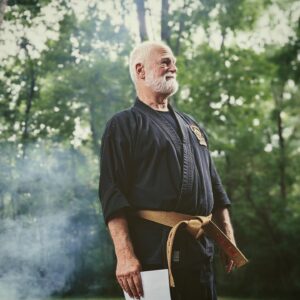Meditation is the practice of focusing the mind’s attention for channeling energy, properly integrating mind and body, and experiencing personal growth
In a quiet place, relatively free from distraction, sit in a straight-backed chair or on a firm pillow.
Your seat should be higher than your ankles. If your knees stick up way higher than your seat, use a firmer pillow to lift you higher. If you are uncomfortable on the floor, sit on the forward edge of a straight back chair.
Sit up straight. Allow your muscles to work actively to keep you upright. Leaning back leads to drowsiness.
Fold hands together palms-up. Fingers of one hand rest on top of the insides of the fingers of the other. Flatten your thumbnails with the tips barely touching. When you look down you should see the flat thumbnails and upturned palms beneath them.
Sit with spine straight but not stiff. Imagine a straight line running from each ear lobe to the top of each shoulder. Elbows are not too far in, not too far out. Tongue rests lightly against the back of your front teeth and the roof of your mouth. Rock slightly in all four directions to settle yourself in.
Keep eyes open just enough to be aware of light coming in under lowered lids. With eyes half-open and half-closed, gaze at the ground in front of you. Allow your eyesight to reach out in front effortlessly. Do not concentrate fiercely. Meditation with closed eyes can result in “inner television”. Shopping lists, old quarrels, and “if-onlys” begin to sneak onto the screen.
Center on breathing to channel the mind. Sit lightly and observe your breath. Lightly examine its quality. Is it deep or shallow, tranquil or in turmoil? Observe your breaths as they arise and fall away. Repeat to yourself, “Breathing”, once for the inhale and once for the exhale. Repeat the process for ten repetitions.
If you find yourself thinking, do not be annoyed. Inwardly smile to yourself, remind yourself “not now”, and let the thought go. Observe in unattached fashion and return to following the breath without any self-criticism. Do this practice long enough, often enough, and ever so gently the thoughts begin to retreat and you will find the mental stability you seek.
Since the beginning of history, people have disciplined their minds to stimulate states of well being with the release of endorphins. Recent research indicates these potent natural substances are byproducts of physical and mental well-being in people who have a positive viewpoint of themselves and others.
Remember that enlightenment is not some external thing you have to “go get”. Its potential is inherent in us all. We find it within ourselves. Kukai (774-835) and Saicho (767-822), founders of the Shingon and Tendai esoteric traditions in Japan, advocated “realizing enlightenment in this very body”. The monk Hakuin said that all beings are enlightened, just as all ice is by nature water. Lin Chi (ca. 866), the founder of the Lin Chi school of Ch’an in China (Rinzai Zen in Japan), commented on this dormant potential in the core of all of us, “When you split open the cherry tree, where is the blossom? Yet in the springtime, see how it blooms!”
Click to go to SKH Quest Shop for Meditation for Martial Artists DVD instruction in mind centering practice.

How I Failed My Yellow & Black Belt Test | Stephen K. Hayes says:
[…] Forty-five years later, I am pledged to helping others learn. My latest lesson offering deals directly with that tendency for the mind to be in the wrong place at a crucial time. I call it the “Here and Now Focus Meditation”. Try it out at “How to Meditate”. […]